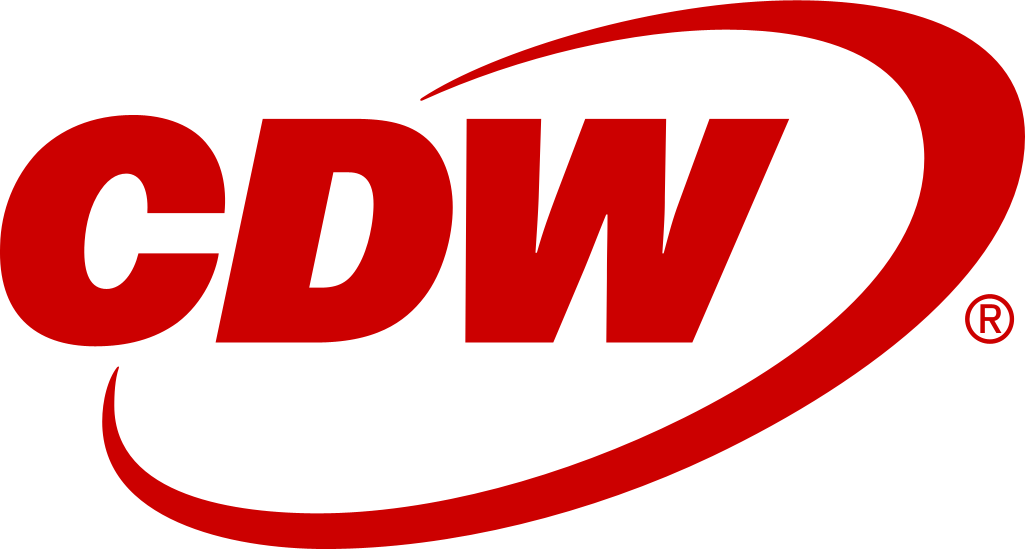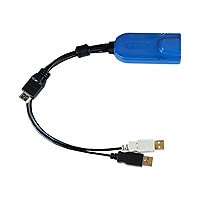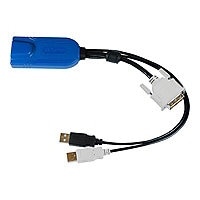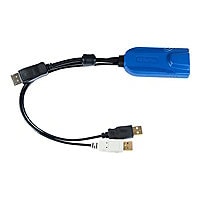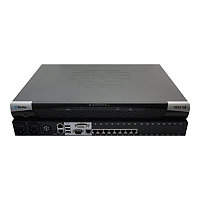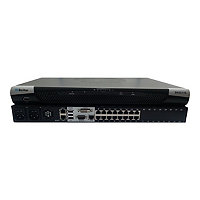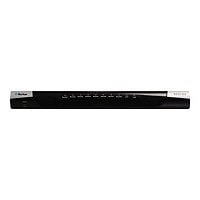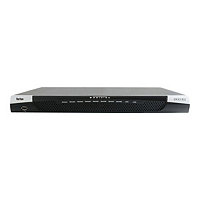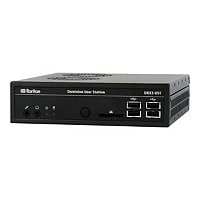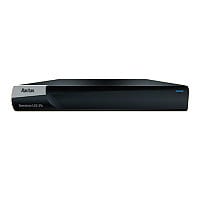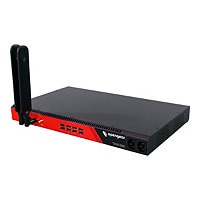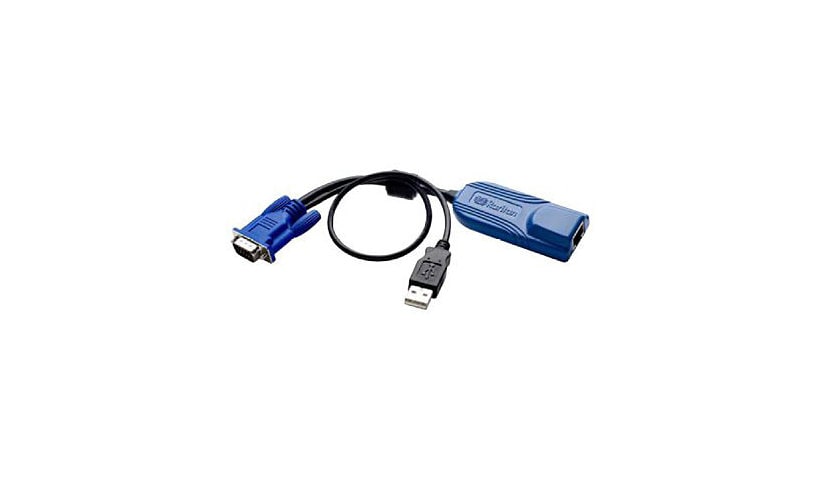
Know your gear
The Dominion KX II solution consists of the KVM-over-IP switch and Computer Interface Modules (CIMs).
CIMs connect to the server's KVM ports and can be located up to 150 feet away from the switch using UTP (Cat5/5e/6) cabling. CIMs also provide keep-alive keyboard/mouse emulation.
CIMs connect to the server's KVM ports and can be located up to 150 feet away from the switch using UTP (Cat5/5e/6) cabling. CIMs also provide keep-alive keyboard/mouse emulation.
Add to Compare
Enhance your purchase
Customers Who Bought Products in Your Cart Also Bought
Raritan Dominion KX II Computer Interface Module is rated
4.10 out of
5 by
21.
Rated 5 out of
5 by
Abdelrahim-Ahmad from
Provides good object storage functionalities
What is our primary use case?
MinIO is a very good system, and it's very suitable for people seeking an object storage system that is very similar to Amazon S3 and hosted locally. It's not in production yet, even though we have been working on it for years.
I haven't tested the solution's performance. I haven't done any heavy tests on the platform. We do not use the tool for really big data, but we use it for mid-sized datasets. The solution's performance is good. I can't complain about it because we don't have the best design.
What is most valuable?
I use the solution's basic object storage functionalities, like AWS S3 compatible APIs and creating buckets.
What needs improvement?
MinIO should provide an easier subscription model for companies that don't have a huge amount of data. Our company has a maximum of 100 terabytes of data. The solution should provide more bugging tools in the open-source version to encourage people to buy the support services.
It's not an easy decision. If I go to the management and tell them that I need to buy a service, there should be an easier subscription model for companies that don't have huge amounts of data. For me, getting a subscription for 15,000 a year for a system already in production might be a bit hard.
I think MinIO supports a minimum of one petabyte or 100 terabytes of data. Since we don't have such huge amounts of data, buying a subscription for the solution is a bit difficult. Hence, we're only using the open-source version for now. If MinIO becomes really crucial for our business, we could ask the management to get a subscription.
For how long have I used the solution?
I have been using MinIO for two years.
What do I think about the stability of the solution?
MinIO is a stable solution.
I rate the solution’s stability a nine out of ten.
What do I think about the scalability of the solution?
There are some limitations on the number of hard disks and nodes you can add to the solution. The solution works for small, medium, and enterprise businesses, depending on their data model. In an organization with a huge data set and requirements for big data, MinIO can be managed by a team or one or two users.
I rate the solution’s scalability an eight out of ten.
How was the initial setup?
The solution's initial setup is really easy and straightforward. I have done stand-alone setups in Linux, Docker, Docker Compose, and Docker Swarm.
What's my experience with pricing, setup cost, and licensing?
We use the solution's open-source version.
Which other solutions did I evaluate?
MinIO's cloud version has a couple of competitors, like Google File System and Amazon S3, which are cheaper than MinIO. There are no alternatives to MinIO's on-premises version. There are some, but they have a different model. What makes MinIO unique is its compatibility with Amazon S3.
What other advice do I have?
The solution's integration with AI tools is very easy, and I rate it ten out of ten. Because of Amazon S3 compatible APIs, what works with Amazon also works with MinIO. I have tried this often in many use cases, and it seems good. I would recommend the solution to other users.
Overall, I rate the solution a nine out of ten.
Which deployment model are you using for this solution?
On-premises
Disclaimer: I am a real user, and this review is based on my own experience and opinions.
Date published: 2024-09-09T00:00:00-04:00
Rated 5 out of
5 by
Aleksandr Motuzov from
Easier data storage and integrations but has performance challenges
What is our primary use case?
We use MinIO as a cloud storage solution specifically for our data science team. It helps us share data and organize segregation of duties and security rules based on the S3 API and credentials. We leverage it to manage access and role-based models, among other tasks.
How has it helped my organization?
We use MinIO as a cloud storage solution, which is easy to integrate with our data science tools. This means our data scientists can handle extensive data processing and analysis more seamlessly.
What is most valuable?
MinIO is easy to install and use, especially for standalone installations. It supports S3 API integration, which makes it compatible with various data science tools and simplifies the organization of storage classes in Kubernetes.
What needs improvement?
The main issue we face with MinIO is performance. We need higher I/O capabilities for extensive data read-write operations, especially when dealing with big data and Parquet formats. The issue might be related to our simple deployment setup, but it still affects usability.
For how long have I used the solution?
We have been using MinIO for about six months.
What do I think about the stability of the solution?
MinIO is generally stable, but we have noticed occasional performance downgrades when our data scientists perform extensive data read-write operations. We need more observability and monitoring to understand these occurrences better.
What do I think about the scalability of the solution?
We are not happy with MinIO's performance scalability, as we need more I/O capabilities to handle big data.
How are customer service and support?
I personally have not contacted MinIO's technical support, but I know some colleagues who have, and they were generally happy with the service.
How would you rate customer service and support?
Neutral
How was the initial setup?
The initial setup of MinIO is straightforward. It took us about a week, which included discussions, reconfiguration, and running tests.
What about the implementation team?
Our IT team, comprising a few members, handled the installation and initial setup.
What's my experience with pricing, setup cost, and licensing?
It's hard to compare pricing as we are looking for a solution that includes vendor support, which would ensure reliability and ease of operations. Comparing MinIO to other vendor-backed solutions is challenging in this context.
Which other solutions did I evaluate?
We evaluated other vendors like Dell for their monitoring and support capabilities.
What other advice do I have?
I'd rate the solution seven out of ten.
Which deployment model are you using for this solution?
On-premises
Disclaimer: I am a real user, and this review is based on my own experience and opinions.
Date published: 2024-09-25T00:00:00-04:00
Rated 5 out of
5 by
NandaKumar1 from
Easy to install, easy to configure, and you can get it up and running in minutes
What is our primary use case?
My primary use case is to help our customers integrate with MinIO to do file-sharing collaborations.
How has it helped my organization?
MinIO made it easy to collaborate with Amazon SDK.
What is most valuable?
The most valuable feature is file storage.
What needs improvement?
The product's security is open by default, without any SSL, which could be an area for improvement. I don't think I would request any new features in the next release, as the product currently meets all my needs.
For how long have I used the solution?
I have been using MinIO for about six months.
What do I think about the stability of the solution?
The stability of this solution is great - with any file that we uploaded or downloaded, we found it was quick to respond.
What do I think about the scalability of the solution?
My impression is that MinIO supports a wide range of clustering, and I believe it should work in a highly scalable environment for people with larger platforms and larger storage.
How was the initial setup?
The initial setup was very easy - one click, and it was installed. That's what is great about MinIO.
What's my experience with pricing, setup cost, and licensing?
MinIO is open source, but it also has an enterprise license available if preferred.
What other advice do I have?
I feel MinIO is the best solution to recommend to anyone who requires on-premise S3-compatible storage. It is easy to install, easy to configure, and you can get it up and running in minutes, not hours or days. I would rate this product as nine out of ten.
Which deployment model are you using for this solution?
On-premises
Disclaimer: I am a real user, and this review is based on my own experience and opinions.
Date published: 2021-11-21T00:00:00-05:00
Rated 5 out of
5 by
reviewer1684911 from
The user and command line interface are helpful
What is our primary use case?
Generally speaking, we use MiniIO for storing unstructured or semi-structured data. In my current project, we were using it for the semi-structured data. We also use MinIO as a data link. The data is transformed and loaded onto MinIO. And MinIO is used to rate the statistics based on the data.
So I'll just briefly explain how the entire flow works and how the data comes into the menu. After we transform the data, we input it into MinIO. The raw data is in different formats. It is in a delimited, positional-specific, or some other format. And three types of data—virtual, date and time, and numeric—are being loaded, including all Python and Java date formats and various kinds of normal data. Once we transform the data, we load it onto MinIO.
The development and QA teams are the primary users. They work on MinIO together to load the data. So, for the lower environment, the subsequent systems directly read the data from the menu and then utilize it for visualization. The actual end-customer is not reading the data directly from MinIO.
How has it helped my organization?
Earlier, the organization experienced some issues transforming the data and loading it into the technology, so we adopted Spark, and the data was to be loaded onto the menu, MinIO. In terms of the volume, processing speed, and accessibility of data, MinIO was outstanding. First, it worked well for storing large volumes and sizes of data. Second, you can retrieve, load, or transform data with MinIO quite fast. It is a backbone to the organization because it loads the data and stores it after transformation, then all the lower systems can use it.
What is most valuable?
For starters, MinIO has a good user interface. You can access it through the browser and perform operations like creating the object. And inside that, you can make the bucket manually. You can also access it through the command-line interface. Using the command interface, you can perform a complete set of operations — create the bucket, open it, read the data, delete those buckets, etc. — and it is pretty fast
What needs improvement?
The Distributed User Interface (DUI) needs some work. It's hard to view a large set of data on the DUI. It's an issue with the DUI's performance. One way to improve this would be to allow a large set of data to be directly viewed on the UI. Usually, business people do not access the data through the command-line interface. So the DUI tool could be helpful if MinIO improves its performance and ability to handle a larger sample of data. When you're working with a small set of data, the DUI can download that quite easily. But if the data set is vast, it takes time. It becomes quite challenging to view that or download that data. So maybe introducing a PLI command-line interface could improve the DUI function. That would be very useful for the end-user.
For how long have I used the solution?
I've been working with MinIO for about a year and a half to two years.
What do I think about the stability of the solution?
We have not faced any stability issues or had any problems accessing the data on MinIO that I can recall.
What do I think about the scalability of the solution?
I think scalability-wise, MinIO is quite good. However, we had to do some MinIO cleanup activity on the lower environments. By lower environment, I mean the test or development environments. So we had limited capacity in the lower environments. But overall, we have not faced many issues in terms of scalability. Space was available whenever it was required. On the other hand, we could not automate scalability. We had to perform cleanup activity on the lower environments manually.
How are customer service and support?
I haven't interacted with the MinIO technical support.
How was the initial setup?
I did not help set up MinIO, so I will not be able to answer that question. An in-house DevOps team deployed it. Installing new versions of MinIO does not take much time. The entire deployment process took around two days for us, including deploying the code of different modules or different features. But I don't think the basic setup of MinIO took a very long time. It was installed in 10 minutes or so. The DevOps team, which includes around three to four people, upgrades MinIO from time to time.
What other advice do I have?
I rate MinIO eight out of 10. It has a good UI, and it allows you to use the command line, which has a solid list of operations that you can perform. My advice to anyone who implementing MinIO is to take advantage of the command-line interface. It's pretty good to use. If you use the command line wisely, it is a highly efficient feature.
Which deployment model are you using for this solution?
Private Cloud
Disclaimer: I am a real user, and this review is based on my own experience and opinions.
Date published: 2021-10-06T00:00:00-04:00
Rated 5 out of
5 by
Omkar Dhulap from
Great compatibility with different kinds of storage and easy to use
What is our primary use case?
A multi-tenant data space solution that in our case, consumes and stores large amounts of traffic sensor data for multiple cities worldwide.
Right from the start the data-space solution we were building was supposed to be cloud native & cloud agnostic, hence instead of interacting with AWS-S3 using SDK we were using minIO as a gateway over AWS-s3 store.
We're long-standing customers of MinIO. I was a senior member of the technical staff with the team who built the data-space solution.
How has it helped my organization?
While being well suit for kubernates, MinIO also made solution cloud agnostic in storage operations.
For one of the customer due to regulatory constraints, we had to deploy the product on-prem with no access to AWS or open internet. MinIO out-of-the-box supports NFS share (volume) object store. It meant that rather than having to look out for or move to a new product we could stick with MinIO and adapt to newer environment requirements. Secondly, the APIs are quite well documented, including the setup onto Kubernetes clusters and we were able to reduce our ops efforts.
What is most valuable?
The solution has good compatibility with different kinds of storage and that was a major feature for us.
We were using Presto, a query engine, which out-of-the-box connects to MinIO.
MinIO provides APIs which have extensive documentation.
The solution also has a good UI. During the development phase team sometimes needed to go through the data structure to see how data was getting stored. The UI helped us to debug the data quickly.
MinIO is easy to understand, simple to implement and provides a good feature set.
What needs improvement?
There is nothing major that needs to be improved.
While using some of the advance features of MinIO we encountered the minor bugs but they generally get fixed in version upgrades.
I would like to see some kind of graphical representation of underlined data on MinIO UI. Like size, document type etc.
For how long have I used the solution?
I've been using this solution for a year and a half.
What do I think about the stability of the solution?
Setting up MinIO on Kubernetes has its own perks. In terms of stability, Kubernetes took care of most things like spinning up new pod/node when existing one is down. More over MinIO itself is quite a stable application with less of application crashing instances and hardly any downtime in any of our environments.
What do I think about the scalability of the solution?
With high availability configuration it's easy to scale when running on Kubernetes.
From a development team perspective, we have around eight users for either the console or API. From the application perspective, we had Presto, the query engine with connecting with system user.
How are customer service and support?
Because the solution is open source we used the community to find solution of most of the problems we ran into.
How was the initial setup?
The initial setup was quite a straightforward process. The documentation which was provided in the Helm chart repository, was quite comprehensive and easy to access. The DevOps team carried out the deployment. Deploying the helm chart with default configuration doesn't take much time, it's a single line command. But if you want to do high availability production grade setup, then it might take couple of days.
What about the implementation team?
Inhouse team set it up & maintaining it.
What's my experience with pricing, setup cost, and licensing?
The solution is free for personal use but for large organizations/ commercial use, seems there are some charges involved.
What other advice do I have?
If you want to go with MinIO setup, I suggest using a Kubernetes-based setup using helm chart because it's quite easy to manage and will less of a learning curve.
I rate the solution eight out of 10.
Which deployment model are you using for this solution?
Private Cloud
If public cloud, private cloud, or hybrid cloud, which cloud provider do you use?
Amazon Web Services (AWS)
Disclaimer: I am a real user, and this review is based on my own experience and opinions.
Date published: 2021-10-06T00:00:00-04:00
Rated 5 out of
5 by
PRATIK MISHRA from
Bit rot protection and beautifully designed interface.
What is our primary use case?
I was using MinIO for my own research and some other work which I cannot disclose.
How has it helped my organization?
MinIO has brought more scalability, use of computing resources, and it can lead towards higher cost savings for companies.
What is most valuable?
The features that I have found most valuable with MinIO is its coding bit rot protection and how it distributes the workload over all the servers. I observed that the workload is very even in all the nodes.
What needs improvement?
I like the interface. It's beautifully designed and it's great. It's one of the best platforms I've seen and it is highly compatible. The only downside I see is that you do not have a complete picture of an object.
Additionally, a feature I would like to see in the next release would be if they can include an uneven disk structure. Then you can use an uneven number of disks and create a bunch of tickets by a factor of two. If I could use an odd number of disks, that would be better, it would give me more flexibility.
What do I think about the stability of the solution?
MinIO can sometimes crash because of the dependency in underlying OS software layers. Of course it crashes depending on the file system. There is a heavy dependence on the node's file system, that is another issue.
MinIO requires ongoing maintenance by the staff. Their interface is pretty good, it just needs a software upgrade.
What do I think about the scalability of the solution?
MinIO should be easy to scale. It's an evenly scaling system.
I have plans to increase the usage.
How was the initial setup?
The initial setup was simple.
You just need one person to do that part of the small cluster and I had a pretty small cluster so it didn't take much time - maybe half a day.
What other advice do I have?
My advice to anyone considering using MinIO would be to first check if the open source version works for you. It probably should be able to. It has an S3 plugin so quite easily you can have interoperability between the public and private cloud or a hybrid setup. That is one advantage of the system. So if you need a private enterprise working as a public cloud, then MinIO is one of the best solutions I've seen so far.
I was using it for my personal work and MinIO it's a high-performance object storage system. So when you need high performance, you should go to MinIO.
On a scale of one to ten, I would rate MinIO an eight.
In the current market, when you have so many options for objects storage, MinIO is completely open source and an all inclusive package offering you both stability and scalability and its most attractive feature is the S3 plugin which is very similar to AWS.
Which deployment model are you using for this solution?
On-premises
Disclaimer: I am a real user, and this review is based on my own experience and opinions.
Date published: 2021-10-05T00:00:00-04:00
Rated 5 out of
5 by
Anton Ushchapovskiy from
Good file management, but has some connection issues
What is our primary use case?
We are a service provider for the financial sector. We make solutions for our biggest town and guys from this town. The government is trying to keep specific information inside the country, so we developed a solution with that goal in mind.
MinIO was deployed in the center of the Kubernetes cluster, and it's used for keeping files. What's more interesting is how MinIO works with a file. So we used our widget in this instance. For the first approach, we got files from a user proficient system, I believe it's called. We got everything moving on FTP. After that, we put it all into MinIO on our internal partition. So that means transforming and preparing for transfer to the bank. With MinIO, you are preparing a pipeline of folders, where each folder maintains a particular stable file. So for that, we're using MinIO's ability to work with attributes and transfer copies of region files via the stream. As a solution, we use MinIO just like a file keeper. We use characteristics for storage then triple the small source from history
MinIO's use case varies from project to project. In that case, guys from the company used MinIO as a solution for their particular system. It wasn't my decision to use MinIO. For my company, we use another approach because I work at Russian Post. It's a specific company with government contracts, and we have a lot of work requirements about what solutions we can use.
What is most valuable?
MinIO can work with attributes and folders, and it has the ability to use a stream approach for files. I have moments that should work exclusively. It also has some management features you can use, like exclusive locks that you can perform on one record or a collection.
What needs improvement?
MinIO has behaved strangely in the past. For instance, the application dropped connection to MinIO. It's not too significant, but it loses connection. We're trying to understand exactly what is happening when this happens. Maybe the team at MinIO should work on this error because, at this time, it's unclear why this happens.
For how long have I used the solution?
We've used MinIO for three months. We made two solutions in MinIO and used it to keep the bank's files and write up payment systems.
What do I think about the stability of the solution?
I've never had trouble with the equipment, especially with DUI surges. I had connectivity issues, but it's not a problem with MinIO. The general lot level was not so high, and it didn't present any problems. Since we're not getting so many requests, we keep it all in MinIO and process it.
What do I think about the scalability of the solution?
I think MinIO is not so hard to scale. Our guys are using part of this scale to replicate data, and this process was not very hard to scale. Right now, we have two teams using it. We make a solution for the financial part, and the other guys make one for customer data. And two teams were enough for that time. It was 10 or 12 developers.
How are customer service and support?
I've never had to call MinIO support
How was the initial setup?
Guys from DevOps helped us, so setting up MinIO was not so difficult.
Which other solutions did I evaluate?
Compared to SAS, MinIO is more straightforward from the developer side. It's easier to work with API. Most file solutions are similar when it comes to storage and how they work with ChAS SCP and Java. And when I compare, I'm trying to understand what the goal is and what level the developer should be working on with one of the solutions. I think MinIO is easier to use compared to Java API or for working this fast.
What other advice do I have?
I rate MinIO seven out of 10. I say seven because I've worked with finance and require consistency and work with exclusive locks. From the standpoint of a coder or a developer, it's a good solution that's easy to use, connect, and prepare requests with. It doesn't require a lot of complex skills, and it's easy to put into your application.
For people considering MinIO, I generally recommend understanding what level of consistency you want when working with these files. Also, you want to consider what kind of file reporting procedure you need, like streaming or batch processing. And, if you want some locks, like exclusive locks, then maybe you don't want MinIO. But for other sites, it's suitable.
Disclaimer: I am a real user, and this review is based on my own experience and opinions.
Date published: 2021-10-17T00:00:00-04:00
Rated 5 out of
5 by
Nasrudin Salim Suden from
Scales very well and provides the ability to spawn a MinIO Tenant on demand and shut it down right after
What is our primary use case?
We used it for machine learning artifacts in terms of model weights and the model outputs for visualizations for ephemeral tasks.
I was using it less than a year ago, and it was the latest open-source version.
How has it helped my organization?
It helped us to use AWS because we wanted a hybrid solution or to move to AWS eventually. MinIO provided that bridge. We could write code only once and make it work with MinIO. When we move the same code to the cloud to scale it, it will still continue to work.
What is most valuable?
The ability to spawn a MinIO Tenant on demand and shut it down right after is most valuable.
What needs improvement?
There should be the ability to expand the size after it has already been deployed. Currently, you cannot do that. It doesn't support an increase in size. Each time we spawn a new MinIO, we need to track the particular MinIO instance or tenant that has the file. Therefore, we had to create a multi-tenant solution that tracks the MinIO that has our artifacts. It isn't in one single instance. It should have better multi-tenancy support.
What do I think about the stability of the solution?
On Kubernetes, it wasn't as stable as we wanted it to be.
What do I think about the scalability of the solution?
It scales very well. It integrates quite well with other solutions.
We had probably a couple of hundred users. Their titles were Machine Learning Engineers or DevOps Engineers.
How are customer service and technical support?
I didn't have to call up MinIO for tech support. There is documentation, but it is not so good.
Which solution did I use previously and why did I switch?
We are phasing it off, and we are going to AWS. We have stopped using MinIO. At the moment, we are using Alluxio.
How was the initial setup?
It was a bit complex. The complete deployment took about a month and a half.
We used Kubernetes YAML files because we were using MinIO on Kubernetes. Once that was up, we had to expose the MinIO instances via load balancers. That's how we connected MinIO.
In terms of maintenance, we have to make sure that we're always using the latest version. So, we have SRE people deployed to just monitor the health and versions. We have to update a few hundred instances of MinIO.
What other advice do I have?
I would advise others to not use MinIO on Kubernetes. I would rate MinIO an eight out of 10.
Which deployment model are you using for this solution?
On-premises
Disclaimer: I am a real user, and this review is based on my own experience and opinions.
Date published: 2021-08-15T00:00:00-04:00
Rated 5 out of
5 by
Francisco Capllonch Alcover from
Provides an excellent approach to development and testing environments
What is our primary use case?
Our primary use case of this solution is for the microservices architecture built with .NET Core. I'm a senior software engineer and we are customers of MinIO.
How has it helped my organization?
The solution has provided the company with a super approach in development and testing environments which is what we were looking for.
What is most valuable?
The solution has a good interface. We initially used several commands for configuring in the Docker Compose to create the default bucket and to make it public. It was pretty easy to use and fulfilled our requirements. It's quite powerful.
What needs improvement?
We had some issues with the initial configuration which I think could be improved by working on the documentation. I had to search different sources to get what I needed.
The MinIO client was hard to automatize, we had to include some scripting on startup of the client container so that the buckets were setup with the read/write permissions and to make it public and accessible
For how long have I used the solution?
I've been using this solution for two years.
What do I think about the stability of the solution?
We haven't had any issues with stability.
What do I think about the scalability of the solution?
The way we deployed the test environment was to have just one instance for every container so every user was able to run their own test environment and we didn't need to scale. There were somewhere between 20 and 30 users, product owners and testers. The solution didn't require any maintenance. Expanding use will depend on the amount of information they have to store.
How was the initial setup?
In the test environment we were using Terraform scripts with the commands for the MinIO Client to set up the MinIO, and all the containers were deployed to a Nomad Ecosystem. We used the continuous deployment to deploy and create the test environments with Azure DevOps. There were three back end developers and two DevOps people that helped with deployment but I did most of it, configuring the continuous integration and deployment of the project.
The most difficult part of the setup was to configure the MinIO Client, because I'm used to working with Windows and the Docker containers were running on a Linux container. I had to figure out the commands, create the bucket and make it public. It took a bit of research and documentation was an issue.
What other advice do I have?
The solution was intended for private cloud, but we also had an on-premise installation which meant we could manually install the MinIO in every computer required. For on-premise installations, we could install MinIO and just change the connection string of the service using that MinIO. I recommend the solution, it's quite simple to implement and is very powerful because if you need to run the storage in your computer it's as simple as having a container of MinIO.
I rate this solution eight out of 10.
Which deployment model are you using for this solution?
Private Cloud
Disclaimer: I am a real user, and this review is based on my own experience and opinions.
Date published: 2021-09-05T00:00:00-04:00
Rated 5 out of
5 by
Süleyman Fazil Yesil from
Great for finding compatible libraries
What is our primary use case?
I am a software developer. My company was using MinIO to build new frontend applications. We were modernizing the desktop branch application into a web application because it was a modular application with lots of screens.
We didn't want the architect team to increase the size of the client applications. We also did not want a single package as our clients in rural areas would not be able to efficiently load application pages from a very long package network.
We were looking for a better way to optimize the load so MinIO was able to customize web packaging for the frontend and then decompose the web application components. We were packaging everything into a single package. By using MinIO we now optimize the transfer by providing storage for the packages.
Also, our development team had been deploying machine learning algorithms and modules were being produced. Some of these pilot projects do not end up going into production, so we use MinIO as storage for the data produced from machine learning. It works like a Git for machine learning models. The data is posted to Git and the actual files with the hashes are stored in MinIO. The IDs of those models are stored as metadata. It's a model versioning system for machine learning projects.
We deploy MinIO in our data centers as a local version.
What is most valuable?
The most valuable features are that MinIO is open, it works on-premise, and is compatible with the Amazon industry which is great for finding compatible libraries in many languages which is very good for developers.
What needs improvement?
MinIO could use a time patch on it. It could also use better documentation for some languages like Python.
For how long have I used the solution?
The company I was working for had been using MinIO for almost two years.
What do I think about the stability of the solution?
The company was using MinIO in production, it was stable because we depend on it for production. I have complaints about the stability.
Which solution did I use previously and why did I switch?
The company was just putting files on a server disk prior to using MinIO.
How was the initial setup?
The solution is a service provided to developers, so our systems and DevOps team was responsible for deploying MinIO.
What other advice do I have?
I did not have any problems with MinIO, I would rate it a 9 out of 10.
Which deployment model are you using for this solution?
On-premises
Disclaimer: I am a real user, and this review is based on my own experience and opinions.
Date published: 2022-01-20T00:00:00-05:00
Rated 5 out of
5 by
Joe Quaill from
Has good container installation features
What is our primary use case?
I am a solutions architect. MinIO is a public cloud type of storage that can attach external storage volume. I run it proprietary, or open-source. I use it to run a lot of test instances and production, spinning a new product out of it. In general, I use it for the S3 cloud storage capabilities.
Internally in our company, we have five people that use MinIO by putting their data in and heavily pound it for testing efforts.
How has it helped my organization?
With different types of storage, MinIO enables me to create these storage volumes called buckets, this is an S3 type cloud storage, I can attach these cloud buckets to different types of storage and actually create levels, or tiering of options of storage levels. If you were using Dropbox, I can attach a cloud storage volume to that Dropbox and it can be publicly shared as opposed to you having to do a file sync and share with basic storage.
What is most valuable?
The container installation features are good. The S3 feature provisions the storage buckets making it easy. It allows me to spin up the public buckets with open-source technology.
Another valuable feature of MinIO is Erasure Coding which is comparable to enterprise-based systems.
What needs improvement?
The MinIO dashboard is minimal as there are only a couple of features inside the dashboard for a basic user. I would like this to be more robust with more click-around features.
It is important that MinIO continues to increase its performance. With the increased scaling of specific research coding and the specific throughput the features currently work well, however they need to continue to maintain that community.
What do I think about the stability of the solution?
The stability of MinIO is great. It is a software defined storage that will manage everything well if everything is configured and setup correctly.
What do I think about the scalability of the solution?
MinIO is very easy to scale as it is scale-out architecture. If I need more performance, more memory, or more discs I can add another virtual machine and it attaches to it nicely.
How are customer service and support?
MinIO is open source software. It is community based so its developed by the community.
Which solution did I use previously and why did I switch?
I was using Amazon's S3 and nothing really seemed to work as well as this, until MinIO, the product is comparable. The main reason I switched to MinIO was that it is open source.
How was the initial setup?
Deployment of MinIO depends on what you are trying to accomplish. In my case, it is a four-node cluster with a minimum of four servers, and took myself, a senior cluster role, a full day. The biggest complexity is how you configure the storage around this. You can storage attach, which can get complicated making it an intermediate level of deployment.
What about the implementation team?
This solution is maintained in-house however, there are a lot of factors around that. MinIO manages disc failure, so you need to have hot spares of failing hard drives. You also need to maintain your operating system to make sure that the caching is running optimally and that you get your updates and patches on. Within MiniIO, I look at the caching between the discs. Sometimes you can have files that lock and are holding something up on a certain file.
What's my experience with pricing, setup cost, and licensing?
MinIO is open source so it is free.
Which other solutions did I evaluate?
Hitachi HCP is an option that I compared MinIO against.
What other advice do I have?
Our intention is to rollout MinIO as an enterprise, product offering, to customers. It will be part of a big ecosystem of cloud-based storage. If a company is coming off object storage, or if they were looking at Hitachi HCP be sure that you deploy with your Erasure coding and look into the caching configuration.
As far as functionality and stability on the backend of MinIO I would rate it an 8 out of 10.
Which deployment model are you using for this solution?
Hybrid Cloud
If public cloud, private cloud, or hybrid cloud, which cloud provider do you use?
Other
Disclaimer: I am a real user, and this review is based on my own experience and opinions.
Date published: 2022-01-20T00:00:00-05:00
Rated 5 out of
5 by
Naveed Tejani from
Has many out-of-the-box features like versioning support and management of roles and permissions
What is our primary use case?
The tool helps our customers store documents with their respective versions. Our solutions work around loan processing, loan origination, loan management, and collections. During the loan application process, there is a lot of documentation involved which needs to be stored. The product handles the document’s versioning and storing.
Our solutions also have a module that does the video KYC of our customers. MinIO saves the actual recording of the video KYC process. We use the tool to store and retrieve documents and videos with proper versioning.
What is most valuable?
The tool’s integration is very easy. This feature has helped us reduce development time. The solution also has many out-of-the-box features like versioning support and management of roles and permissions. The product also supports clustered deployment.
What needs improvement?
The tool’s pricing needs to improve. We also encountered challenges while deploying the tool in Kubernetes. The documentation also was not too great. We have currently deployed the solution in a stand-alone fashion.
For how long have I used the solution?
We have been using the solution for two and a half years.
What do I think about the stability of the solution?
The product’s stability is pretty straightforward.
What do I think about the scalability of the solution?
The tool is scalable. It supports clustered deployment which we haven’t used. However, we wrote the documentation and did an internal POC where we deployed it in the test clustered fashion.
How are customer service and support?
We are using the tool’s free version. The free version does not come with any support. However, you can get support from the tool’s strong community. We haven’t run into any issues that require extensive support.
How was the initial setup?
It is difficult to deploy the solution if you involve Kubernetes. The setup is easy otherwise. I believe that it shouldn’t be an issue with the tool’s latest version. The good part is that the tool supports multiple storage technologies
The product has pretty good documentation available on their website which our DevOps team followed and successfully deployed the solution. My team downloaded the binaries from the library, executed them, and made some initial configurations.
The deployment was pretty quick and we were able to complete the process within a couple of days. The Kubernetes part took weeks to complete. You just need a resource with a good understanding of the documentation and experience in Linux technologies to do the deployment. A team of two to three members can complete the deployment in a week’s time.
What other advice do I have?
I would rate the tool an eight out of ten. We use the solution’s community version. My company is the implementer of MinIO and not the end user. We are a fintech company that provides digital lending solutions and digital onboarding solutions to banks and financial initiatives. When we deploy our solutions, we also implement Document Management Systems as part of our solutions. These Document Management Systems use MinIO as the core object storage.
We have not found any issues in the tool’s maintenance. You can get pretty good object storage with the community version. The tool has good capabilities in the enterprise version as well. I would definitely go for MinIO over other technologies.
Disclaimer: My company has a business relationship with this vendor other than being a customer:Implementer
Date published: 2023-03-27T00:00:00-04:00
Rated 5 out of
5 by
Mostafa Ghadimi from
Easy-to-use and easy-to-maintain solution
What is our primary use case?
We use the solution for object storage in our core platform. It works best as a data lake solution for us.
What is most valuable?
The solution is simple to use and maintain for DevOps executives. Also, it has the best performance compared to other solutions.
What needs improvement?
The solution's features for distributed non-container applications and reverse proxy could be better.
For how long have I used the solution?
I have been using the solution for three months.
What do I think about the stability of the solution?
It is a stable solution. I rate its stability ten out of ten.
What do I think about the scalability of the solution?
It is a scalable solution. It uses consistent patching; thus, it is more scalable than other solutions. Although, we encountered a few scalability-related issues while introducing a new node.
Which solution did I use previously and why did I switch?
We used Azure solution before. It was challenging to maintain the Kubernetes cluster.
How was the initial setup?
The solution's initial setup was straightforward. We deployed it through Ansible playboards. It took about three days to complete.
What's my experience with pricing, setup cost, and licensing?
We use the solution's open-source version.
What other advice do I have?
I recommend the solution to start-up businesses. It is the best tool in the market if they want a simple and low-maintenance product. Also, it requires DevOps expertise for the smooth functioning of scalability and reverse proxy features.
I rate it eight out of ten.
Which deployment model are you using for this solution?
On-premises
Disclaimer: I am a real user, and this review is based on my own experience and opinions.
Date published: 2023-05-11T00:00:00-04:00
Rated 5 out of
5 by
Saddam-ZEMMALI from
Easy to use, reliable, and quick setup
What is our primary use case?
I am using the solution for a POC. I am using MinIO to share volumes between different containers.
What is most valuable?
The most valuable feature of MinIO is its ease of use, replication, and active directory. All the capabilities are in this solution.
What needs improvement?
The documentation of the solution should improve.
For how long have I used the solution?
I have been using MinIO for approximately one year.
What do I think about the stability of the solution?
The stability of MinIO is great.
What do I think about the scalability of the solution?
We have approximately eight people using the solution.
The solution is scalable.
How are customer service and support?
I have not used the support from the vendor. I have not had any problems.
How was the initial setup?
The initial setup was simple. We had to download some samples and do the configuration. The process can be done quickly, but the full POC tool many months, and it can be complicated.
What about the implementation team?
I did the deployment of two nodes.
What other advice do I have?
We have done the POC and next will be the production, I recommend the solution.
I rate MinIO an eight out of ten.
Which deployment model are you using for this solution?
On-premises
Disclaimer: I am a real user, and this review is based on my own experience and opinions.
Date published: 2023-05-26T00:00:00-04:00
Rated 5 out of
5 by
Ashis Parajuli from
A tool for storage purposes that helps businesses save time
What is our primary use case?
My company uses MinIO for storage purposes and as a replacement for Amazon S3.
How has it helped my organization?
MinIO has helped speed up the processes carried out by my company's developers.
What is most valuable?
The most valuable feature of the solution is that it offers features similar to the ones offered by Amazon S3. In my company, we needed a tool that we could deploy on a hybrid environment consisting of a private cloud. The solution's use in a hybrid environment is great.
What needs improvement?
MinIO can make it easier to install the product in an OpenShift kind of environment. I think it's a little bit tricky to install MinIO in an OpenShift type of environment.
For how long have I used the solution?
I have been using MinIO for three years. I use the solution's latest version.
What do I think about the scalability of the solution?
Scalability-wise, it is a good solution. I rate the solution's scalability a seven or eight out of ten.
Which solution did I use previously and why did I switch?
I have experience with Apache Hadoop, Amazon S3, and Microsoft Azure. My company uses MinIO due to the cloud-related capabilities that it offers us.
How was the initial setup?
The product's initial setup phase is complex.
The solution is deployed on a hybrid cloud.
One or two people can deploy the solution over a period of two months.
What was our ROI?
I cannot say if I have seen a return on investment from the use of the solution since it is not a paid product. My company uses the open-source version of the product. The product does save time for our company.
What's my experience with pricing, setup cost, and licensing?
My company hasn't tried the version of the solution where we need to pay to use it.
What other advice do I have?
MinIO requires maintenance. One person is required to take care of the tool's maintenance part.
I recommend the solution to those who plan to use it.
I rate the overall product a seven or eight out of ten.
Disclaimer: I am a real user, and this review is based on my own experience and opinions.
Date published: 2023-11-24T00:00:00-05:00
Rated 5 out of
5 by
AbdelrahimAhmad from
A great all-in-one, user-friendly data storage system
What is our primary use case?
We are using this solution as a data link, to store data in a structured dataset. We've been testing the functionalities and how we can integrate our system into it. We are customers of MinIO and I'm a data scientist.
What is most valuable?
This is an all-in-one, user-friendly data storage solution. It provides high throughput to access data. We tend to use AI and some of the resource-intensive applications related to data, like analysis and visualization. I like the S3 API.
What needs improvement?
I feel there is a lack of good addons to integrate without having to use third-party applications. It makes the process time-consuming. It would be helpful if MinIO built artifacts or anything that could be used to stream data into it. That said, I'm not sure MinIO is different from other solutions. Hopefully, data governance will improve in the future. I'd also like to see more support for AI.
For how long have I used the solution?
I've been using this solution for four months.
What do I think about the stability of the solution?
I can't judge stability yet because we're only using a couple of megabytes or gigabytes, it's very small. We probably have three or four potential users in the company.
Which solution did I use previously and why did I switch?
I previously worked with Hadoop which I found to be a little bit more complex than MinIO which is easier to use. I chose MinIO because I like the S3 API. We were looking for an all-in-one solution to backup or to carry out disaster recovery, and to have a place where we can store a new dataset for analysis and something for big data and AI.
I generally recommend it in favor of Hadoop Distributed File System because I can see more benefits and it's a little bit cheaper if you download it on-premises compared to Amazon S3.
How was the initial setup?
The standalone is really easy to deploy. I think we'll deploy four nodes and I'll use Docker Swarm for that.
What's my experience with pricing, setup cost, and licensing?
We are using the free version. This is still a new system and I think it's a good idea to have a free version to test before purchasing a license.
What other advice do I have?
It's difficult to comment on the product because we haven't completed testing or deployed it in the production environment. Moving to MinIO involves a learning curve. It's a question of whether someone is prepared to put in the effort to learn the solution and whether they have sufficient experience. The decision to use it needs to be based on whether it's for backup only or for backup and disaster recovery. Then there's the option to use it for analytics and AI, which is more complex and requires integration with other tools.
Once the solution has more maturity, I think it will become a dominant product. For now, I rate it eight out of 10.
Which deployment model are you using for this solution?
On-premises
Disclaimer: I am a real user, and this review is based on my own experience and opinions.
Date published: 2022-05-02T00:00:00-04:00
Rated 5 out of
5 by
Rene Ribaud from
Stable, reliable and easy to manage
What is our primary use case?
My primary use case of MinIO is to ingest the data coming from devices, and to store the raw files coming from the devices.
What is most valuable?
The most valuable feature of this solution is its reliable erasure coding. It is also easy to deploy and manage.
What needs improvement?
I think the product tends to be more oriented toward Kubernetes and lacks documentation for people who don't want to use it, so they could improve their documentation. They could also better highlight the recommended versions as there are a lot of new versions, and it's difficult to know which is the best to use.
For how long have I used the solution?
I've been using MinIO for two and a half years.
What do I think about the stability of the solution?
MinIO's stability is quite good, except for some synchronization issues.
How are customer service and support?
I've used their Slack account for support, which gave me okay answers.
Which solution did I use previously and why did I switch?
I previously used Red Hat Ceph Storage, which was harder to implement but more robust, with more features.
How was the initial setup?
The initial setup wasn't too difficult and took between five to ten minutes.
What other advice do I have?
You need to monitor disk usage and cluster status, but with correct monitoring, this solution works quite well. It's also important to keep up with upgrades as the product is evolving quite fast. If you need some S3-like solution with common features, MinIO is a good solution. I would rate this solution as eight out of ten.
Which deployment model are you using for this solution?
On-premises
Disclaimer: I am a real user, and this review is based on my own experience and opinions.
Date published: 2021-11-29T00:00:00-05:00
Rated 5 out of
5 by
reviewer1711263 from
Secure and easy tool but setup is difficult
What is our primary use case?
My primary use case for MinIO is as a tool for document management and storage.
How has it helped my organization?
The benefit of MinIO is that it's more secure. It also facilitates our works due to the facility of its end-point course.
What is most valuable?
MinIO's most valuable feature is that we can send a lot of detail in the bottom of the core of the end-point, in a way that is easy and interactive. It also saves a lot of time in generating and managing documents.
What needs improvement?
An area that could be improved is the limited storage provided in the free version of this tool. When handling a lot of documents, the interaction can take a lot of time.
For how long have I used the solution?
I've been using MinIO for the last two to three years.
What do I think about the stability of the solution?
The stability of this solution is fine, though sometimes the duration of responses is too long.
What do I think about the scalability of the solution?
MinIO is easy to scale.
How was the initial setup?
The initial setup was not easy at all. We had some problems since we weren't given the information on how many instances needed to be deployed the first time, which blocked our deployment. It took us one or two days to deploy the product. On the other hand, it was very easy to manipulate and interact with.
What other advice do I have?
I think MinIO is the most efficient tool in the management of documents, and its performance facilitates our works. I would rate this tool as seven out of ten.
Disclaimer: I am a real user, and this review is based on my own experience and opinions.
Date published: 2021-11-29T00:00:00-05:00
Rated 5 out of
5 by
Sankarguru Thirgnanasambandam from
Stable and scalable with simple atchitecture
What is our primary use case?
I mainly use MinIO to store and process unstructured data like customer receipts.
What needs improvement?
The developer support could be better.
For how long have I used the solution?
I've been using MinIO for two years.
What do I think about the stability of the solution?
MinIO's stability is pretty much okay.
What do I think about the scalability of the solution?
MinIO is scalable.
How are customer service and support?
We've used the UI interface and community practice and tended to get a response back within a couple of days.
Which solution did I use previously and why did I switch?
Previously, we had a Hadoop-based database, but the tools and the community service to manage the Hadoop clusters were too expensive.
How was the initial setup?
The initial setup was straightforward as MinIO provided good support documentation and took a couple of days to complete. I would give MinIO a rating of eight out of ten.
Which other solutions did I evaluate?
We evaluated Cloudian and RedHat.
What other advice do I have?
MinIO's architecture is very simple, but since it doesn't go with any particular hardware, sometimes they rely on outside software.
Disclaimer: I am a real user, and this review is based on my own experience and opinions.
Date published: 2022-05-14T00:00:00-04:00
Rated 5 out of
5 by
Vincenzo Agrillo from
Reliable, free, and simple implementation
What is our primary use case?
We use MinIO for enterprise file storage.
For how long have I used the solution?
I have been using MinIO for approximately three years.
What do I think about the stability of the solution?
The stability of MinIO is good.
What do I think about the scalability of the solution?
The scalability is one of the limitations we have found. We are looking for another solution but they must provide the same characteristics, such as an affordable price and continuity.
We have approximately 100 of my colleagues that are using the file service.
How are customer service and support?
I have not needed to use the support.
How was the initial setup?
The initial implementation was straightforward. It took us three days for the process.
What about the implementation team?
We use our in-house team of two to do the implementation. The maintenance is done by three people 10 days out of the year.
What's my experience with pricing, setup cost, and licensing?
MinIO is a free open-source solution.
What other advice do I have?
I rate MinIO an eight out of ten.
Which deployment model are you using for this solution?
On-premises
Disclaimer: I am a real user, and this review is based on my own experience and opinions.
Date published: 2022-02-12T00:00:00-05:00
Rated 5 out of
5 by
Wichein W. from
Easy to use and works with another connector
What is most valuable?
I like that if you have a problem, you can buy the home server. It is stable and robust.
What needs improvement?
The solution should have high availability. Also, support should be quick.
For how long have I used the solution?
I have been using MinIO for two years.
What do I think about the stability of the solution?
The product is stable. If you buy the SSD, then it's good.
I rate the solution's stability a nine out of ten.
What do I think about the scalability of the solution?
The solution’s scalability is good.
100+ users are using this solution.
I rate the solution’s scalability a seven out of ten.
How are customer service and support?
MinIO provides community support. We can find the solution from the community, but it takes a few weeks to get the answer.
Which solution did I use previously and why did I switch?
MinIO is easy to use and works with another connector.
How was the initial setup?
The initial setup is easy and takes one to three hours, depending on the infrastructure. To deploy, download the container and then deploy it on our infrastructure.
I rate the initial setup an eight out of ten, where one is difficult, and ten is easy.
What's my experience with pricing, setup cost, and licensing?
The product is free of cost.
What other advice do I have?
I rate the solution’s performance as seven to eight out of ten.
Overall, I rate the solution an eight out of ten.
Which deployment model are you using for this solution?
Hybrid Cloud
Disclaimer: I am a real user, and this review is based on my own experience and opinions.
Date published: 2024-03-27T00:00:00-04:00
